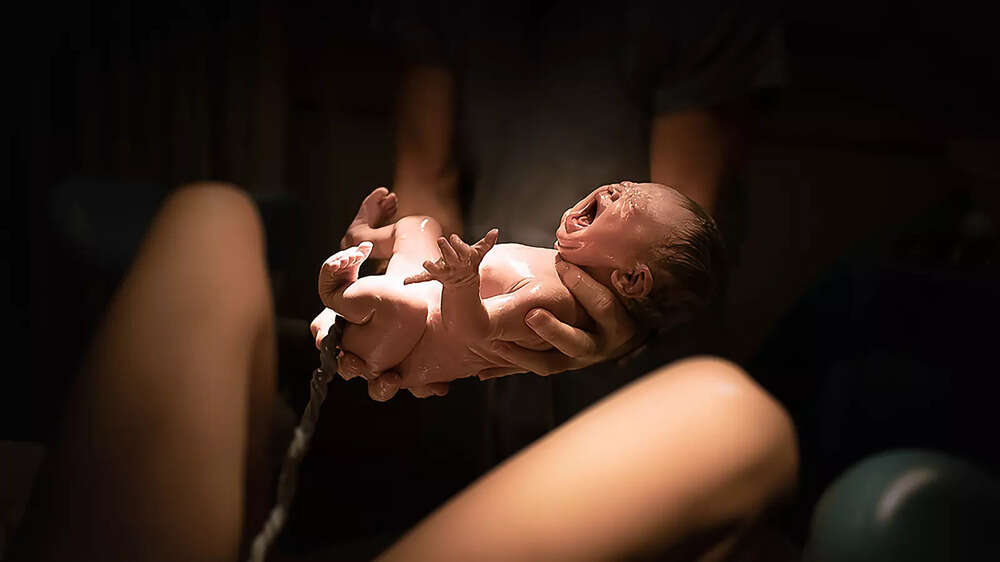In this article:
What Is A Lotus Birth?
A lotus birth incorporates umbilical nonseverance, which is the practice of leaving the umbilical cord and placenta attached after birth and allowing them to separate naturally rather than cutting the cord immediately or shortly after birth.This natural separation usually occurs three to ten days following the baby's birth, but in some situations, it can take up to fifteen days. Until then, the umbilical cord and placenta are still linked to the newborn.
Lotus childbirth is not a common practice, and statistics on how frequently it occurs are difficult to get. However, some data indicates that its popularity is increasing.
Why Is A Lotus Birth Done?
Lotus births are performed for spiritual reasons, in which it is believed that keeping the umbilical cord attached to the placenta after birth fosters a deeper connection between the mother and the baby.How Do Lotus Births Differ From Delayed Cord Clamping?
Delayed cord clamping is extremely different from lotus birth. Delayed umbilical cord clamping involves cutting the umbilical cord and placenta 30 to 60 seconds after birth rather than the typical 15 to 20 seconds. In contrast, a lotus delivery occurs when the umbilical cord and placenta naturally separate from the infant, which can take three to ten days or longer.Delayed cord clamping offers demonstrated scientific benefits for babies, particularly preterm infants, and poses no risk to the mother. According to research, it improves the baby's immunological function and circulation while also increasing iron levels, which helps to prevent anaemia and intestinal infections throughout the child's first year of life.
However, there is no proof that lotus birthing has any advantages. The technique is not advised by major medical organisations, and most medical professionals believe that allowing an umbilical cord and placenta to separate spontaneously can put a newborn at risk for dangerous infections.
Benefits Of Lotus Birth
Lotus birth advocates claim that the procedure allows for complete blood transmission from the umbilical cord and placenta to the baby. This theory is not supported by any scientific data. Parents who choose a lotus birth report that leaving the umbilical cord and placenta intact promotes a more natural birth and that lotus-born babies are more calm and tranquil.
Risks Associated With Lotus Birth
There is no high-quality research to support the benefits of lotus births. However, multiple studies have shown that allowing an umbilical cord and placenta to separate on their own can put a newborn in danger of omphalitis, which is an infection that surrounds the umbilical cord area. These infections can be severe and result in septic shock or even death.Within minutes of leaving the womb, blood ceases circulating to the umbilical cord and placenta. When fresh blood no longer circulates through the tissues, they begin to die (as well as decay and smell). As a result, germs can colonise the placenta and cause infection. If the placenta and infant are still attached by the umbilical cord, the infection can easily spread to the newborn.
In other words, lotus childbirth has been proven to bring life-threatening hazards to newborns, while the benefits have yet to be proven.
Process Of Lotus Birth
It's more about what's not done. Lotus birthing simply means leaving the placenta and umbilical cord alone after birth. It is usually done in combination with home deliveries, as hospitals may refuse to leave a placenta and umbilical cord intact due to infection risks.Some people choose to wash the placenta and apply salt, herbs, or essential oils to help it dry faster and disguise the odour. They may also place the placenta in a bag or wrap it in a blanket or towel to absorb moisture before carrying it with the baby. These practices are done to protect the placenta or lower the risk of infections.
Just like a regular cut umbilical cord stump, the cord and placenta will ultimately dry out and come off, usually within a few days to a week or more after birth.
How Should I Care For My Placenta Following A Lotus Birth?
Lotus births pose considerable health hazards, and most medical specialists do not recommend them. If you decide to do one, take the precautions below to safeguard the area around your baby's belly button and umbilical cord.Keep the placenta close to your infant and lift or hold your baby with clean hands to avoid the likelihood of the cord being tugged, which could result in the cord being pulled out before it is ready to fall off. Dress your baby in loose, comfy clothing that opens from the front.
Do not try to remove the umbilical cord yourself. It should fall out naturally within three to ten days following delivery, but in some situations, it may take up to fifteen days. If you decide to cut the umbilical cord before it falls off, contact your baby's paediatrician.
Seek emergency medical attention for:
- A pus- or fluid-filled mass located around the umbilical cord.
- The skin near the umbilical cord may be red, heated, or swollen.
- Cloudy, foul-smelling discharge or bleeding from the umbilical cord or navel.
- A temperature over 100.4 degrees Fahrenheit.
- Irritability, tiredness, difficulty eating, or reduced activity.
However, if it is something you are quite certain about, consult your doctor while developing your birth plan. They will help you in minimising the risks and determine whether there is a safer method to accomplish it.
FAQs on What Is a Lotus Birth—and Is It Safe?
- Is it safe to have a lotus birth?
A ''lotus birth'' is scientifically unsound, untested, and has been shown to cause significant harm to babies. - Do hospitals allow Lotus Births?
Typically, hospitals will not allow lotus births due to concern for risks to the baby.











